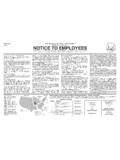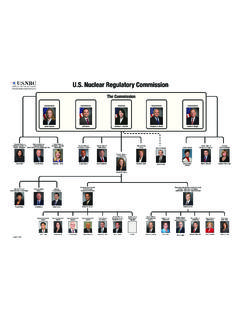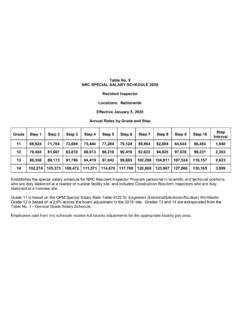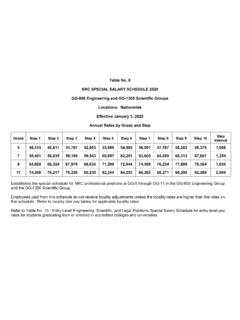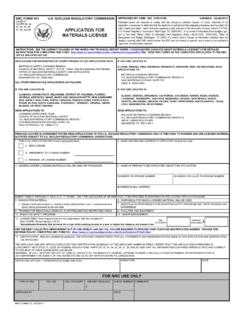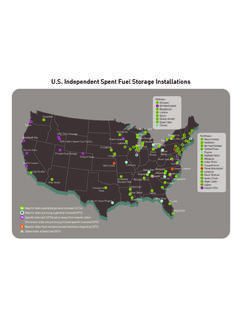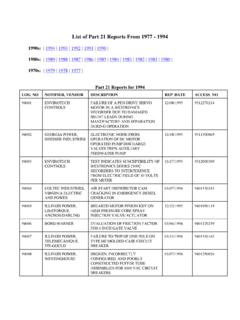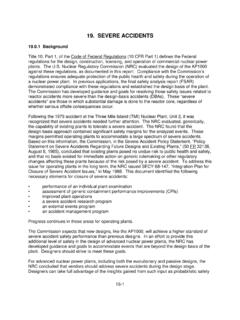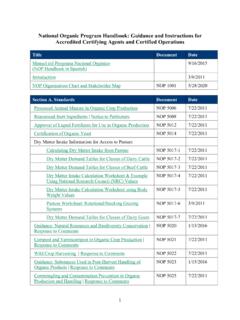Transcription of Collection of Abbreviations - Nuclear Regulatory …
1 NUREG-0544, Rev. 5 Collection of Abbreviations Office of Administration NUREG-0544, REV. 5 Collection of Abbreviations Office of Administration Manuscript Completed: November 2016 Date Published: December 2016 Prepared by: C. Hsu iii ABSTRACT The Nuclear Regulatory Commission (NRC) has compiled this list of Abbreviations commonly used by the agency staff, the Regulatory community, and the Nuclear industry. To create this list, the NRC staff sought to identify Abbreviations that are so commonly used that some staff may not first define the term before using it either in writing or in speaking.
2 This list of Abbreviations is descriptive rather than prescriptive. In other words, this NUREG does not recommend one abbreviation to the exclusion of others. Nor does this NUREG intend to capture every abbreviation ever used in an NRC document . The audience of this NUREG is the public, stakeholders, industry, and NRC employees. The goal of this NUREG is to improve communication with and within the NRC. v TABLE OF CONTENTS ABSTRACT .. iii PREFACE .. vii ACKNOWLEDGMENT .. ix 1 INTRODUCTION TO Abbreviations .. 1 Definitions ..1 Why Use Abbreviations ?.
3 1 How To Use Abbreviations ..2 2 ACRONYMS AND INITIALISMS .. 5 How To Use Acronyms and Initialisms ..5 3 PLAIN LANGUAGE AND Abbreviations .. 7 What Is Plain Language? ..7 Plain Language: It s the Law ..7 Plain Language Resources and Guidance ..8 Plain Language Means Fewer Abbreviations ..8 4 LIST OF COMMONLY USED Abbreviations AT THE NRC ..11 5 NRC Other Guidance ..37 vii PREFACE The Nuclear Regulatory Commission (NRC) publishes this list of Abbreviations to help NRC staff, industry, stakeholders, and members of the public understand the many Abbreviations used in NRC materials and presentations.
4 In an ideal environment, the NRC would not require a reference book of Abbreviations . All NRC documents would minimize the use of Abbreviations , and no NRC staff member would use an abbreviation in writing or speaking without defining it first and then redefining it often. However, the NRC regulates a highly technical and scientific industry. Abbreviations are commonly used to condense long and awkward organizational names, computer code names, Nuclear power plant systems and parts, and many other scientific and technical terms. Even outside of technical fields, Abbreviations arise naturally in language.
5 So naturally, in fact, that sometimes the abbreviated form of the term overtakes the original term. For example, laser originally stood for light amplification by stimulated emission of radiation and scuba for self -contained underwater breathing apparatus. Other abbreviated terms never need a definition. For example, no one would schedule a meeting for 3 post meridium ( ). Within the relatively small and specialized world of Nuclear regulation, it is both natural and efficient for writers and speakers to use Abbreviations that most of their peers will understand.
6 When everyone in a field says HLW and understands it to mean high-level waste, it can feel just as unnecessary to define HLW as it would be to define or laser. The reason that this NUREG is necessary is that not all users of NRC documents work in the Nuclear industry. The NRC s mission is to protect public health and safety, promote the common defense and security, and protect the environment. To achieve this mission, the NRC must communicate regularly with diverse audiences such as Congress, other Federal agencies, State and local governments, Tribal Governments, foreign governments, international Regulatory bodies, concerned citizens, stakeholders, and the general public.
7 In addition, the NRC s Strategic Plan describes openness as one of two cross-cutting strategies for achieving its goals. The agency s activities to achieve openness include, Enhance the readability of NRC materials intended for the general public, and Expand the use of plain communicating technical information. For a general audience, a document with many Abbreviations can be very difficult or nearly impossible to understand. NRC writers should keep the least technical audience member in mind when choosing to use Abbreviations . Even within the agency, technical staff members have different areas of specialization.
8 A resident inspector, a seismic expert, a financial assurance analyst, and an emergency response specialist will each have a different set of Abbreviations that he or she considers to be commonly used. This revision of NUREG-0544 acknowledges that Abbreviations must be used, but it also points out that overuse of Abbreviations can impede communication. For this reason, this revision includes a new section on plain language principles and how to minimize Abbreviations . This revision also greatly reduces the number of Abbreviations presented. The previous revision of this NUREG contained over 8,000 Abbreviations .
9 This revision is streamlined to just over 1,000 Abbreviations . The working group reduced the number of Abbreviations by deleting outdated terms and focusing on Abbreviations that are so commonly used that NRC staff might not define them before use. The list of Abbreviations in this NUREG is descriptive rather than prescriptive. No one abbreviation is recommended to the exclusion of another because the same abbreviation may, with equal validity, apply to two or more terms. This list includes major NRC program and staff offices, viii advisory groups, panels, and boards but not NRC divisions and branches.
10 These can be found on the NRC s organization and functions Web page. Some Abbreviations for organizations that no longer exist are included as historical references. This list does not include most chemical elements, computer codes, and units of measurement. Many of these Abbreviations appear in readily accessible sources such as dictionaries, the Government Printing Office Style Manual, and other manuals. ix ACKNOWLEDGMENT This NUREG is the product of collaboration among staff from different organizations. Kimberly Ferrell, Chief of the Publications Branch in the Office of Administration, contributed the leadership and management of this revision.
